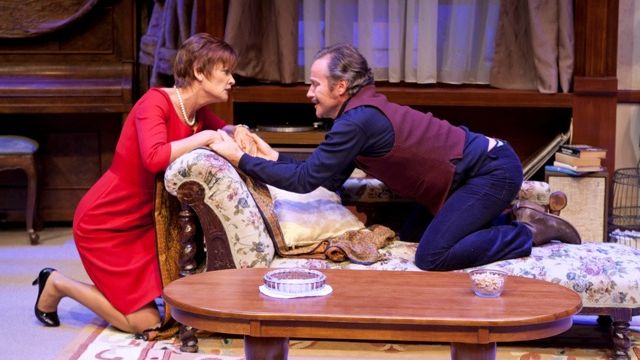The Gingerbread Lady
This is the Ensemble’s third ‘go’ at The Gingerbread Lady (1973, 1987, 2012) and whilst this production is lively and the set impressive, the play, as with most of Simon’s early work, does not sit well in contemporary times. Certainly, the clever, New York-Jewish-style humour still worked for many in the opening night audience. And the delivery of it is beautifully timed. But the play is long (there are two intervals), the dialogue is not economic, and the characters are overstated. This is Neil Simon!
That being said (and it does need to be), the production itself is fine. Director Sandra Bates, the Ensemble and its audiences have a ‘thing’ about Neil Simon, and always do him proud. Fortunately there has been no attempt to take the play into another period. The set establishes that clearly. The brownstone apartment is cluttered with photographs and other 70s paraphernalia, even to the brown drapes on wooden rings and rods. The costumes too are typical of the period. It is New York in the early 1970s. The play, its characters, its humour and its content really wouldn’t work in any other context.
 Bates has cast the play well and her direction of Simon’s work, as always, sustains the style and pace of the play and its time.
Bates has cast the play well and her direction of Simon’s work, as always, sustains the style and pace of the play and its time.
In this production, Kate Raison is compelling as Evy Meara, failed cabaret singer and recovering alcoholic, returning home from a ten-week stint in rehab. Raison gets inside the brittle shell of the character finding her fear and faltering self control. Under her throw-away, carefully timed, superficial humour, she develops and sustains a pathos that makes her Evy more real and believable. She establishes layers in the character that are not obviously there in the lines and engages the belief and empathy of the audience.
Kellie Clarke plays Evy’s seventeen year -old daughter, Polly. Clarke is a clever young actor. She has a strong stage presence, evident particularly in her ability to be still and silent and yet show in her face and body the range of emotions that she is controlling – concern, bewilderment, disappointment, anger. She establishes her character very quickly. She’s come home from her father and stepmother to be with her mother. She is not going to take the feigned (and fearful) nonchalance and rejection her mother offers. She’s there to stay! Not to keep her mother sober, but because she really cares. As does Evy! The scenes between these two characters are probably the reason the play endures. They are more real, less superficial that other scenes. Here Simon finds the right words, the right depth, the truth of their relationship.

The same cannot be said of the lines he gives to Evy’s friends Toby (Danielle Carter) and Jimmy (Tamblyn Lord). Though their scenes are very funny, the characters themselves are shallow and do not give the actors a real chance of character development. Both Carter and Lord are more than proficient in their roles. Carter plays the vain, self-absorbed Toby with excellent pace and immaculate timing. She carries off the flamboyance of her character well, especially in an over-the-top, self indulgent tantrum. She is funny and appealing.
The decision to play Jimmy as very obviously gay from the very beginning – Simon’s description of him in the introduction to Act One is “… portly and probably homosexual. Probably but not obviously.” – does lead in to his mad, once again, over-the-top scene in Act 2, but the portrayal makes the character seem a little too superficial and more of a caricature than his lines might suggest. Notwithstanding, Lord’s depiction of Jimmy’s real concern for Evy is touching, going beyond the words in his script.
The two smaller parts of Manuel, the Spanish delivery boy, and Lou Tanner, Evy’s ex lover, are played by Adriano Cappelletta, who manages to make the most of both roles. He is cheeky as Manuel. He is nasty and manipulative as Tanner. As with most of Simon’s ‘bit parts’ the characters are clear and quite real.
Bates has done her usual thing with Simon’s work. It is funny and appealing and fast – and strictly in context – and because it is Neil Simon, it will appeal to a certain audience. I just wonder if that appeal and that audience might be dwindling a little.
Carol Wimmer
Images: Kate Raison and Tamblyn Lord; Danielle Carter, & Kate Raison, Tamblyn Lord and Kellie Clarke in The Gingerbread Lady. Photographer: Steve Lunam.
Subscribe to our E-Newsletter, buy our latest print edition or find a Performing Arts book at Book Nook.

